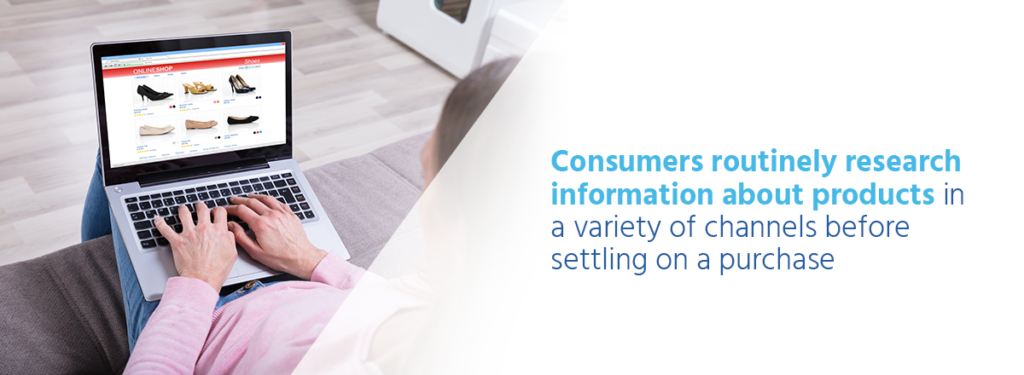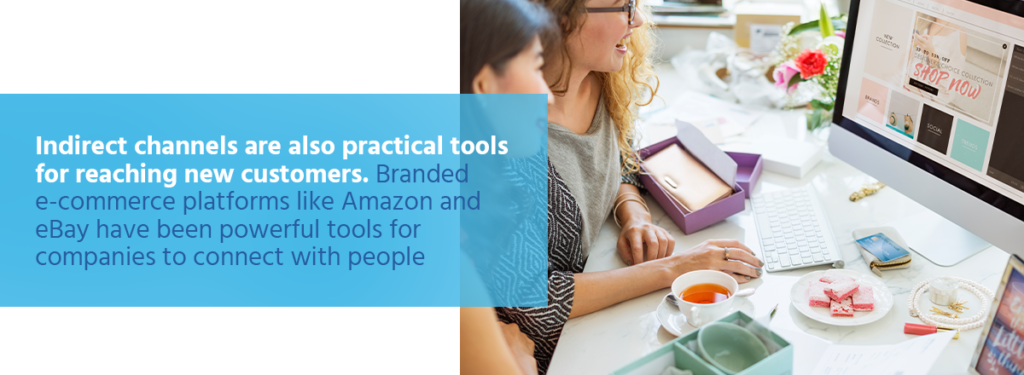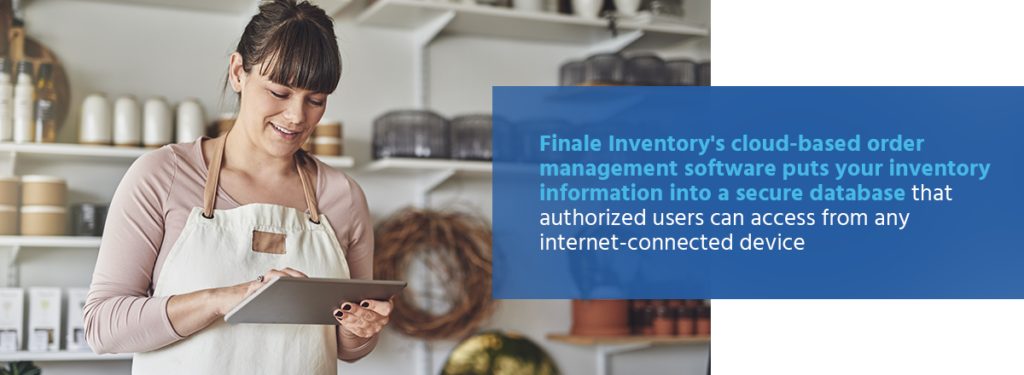E-commerce hit a significant milestone in 2019. Data from the Commerce Department revealed that for the first time, “non-store” online retail sales had a higher total market share than general merchandise sales. E-commerce has seen startling and consistent growth, and businesses of all kinds have embraced opportunities to expand into the new digital channels.
At the same time, traditional brick-and-mortar retail isn’t going away. Online retail has seen consistent growth, especially for specific product categories, but still only accounts for about 12% of the total retail market share. Consumers are buying more goods online, but they’re not exactly abandoning traditional retail stores. Instead, people increasingly expect businesses to give them options. A 2017 poll found over 30% of Americans think retailers must have both an online presence and a physical storefront.
Most businesses can’t afford to focus all their attention on one channel. Consumers are using a wide range of devices and platforms to research new products, gather reviews and impressions from others and ultimately make their purchases. Connecting with today’s technology-driven consumers means meeting them on the new and emerging channels they prefer.
Multichannel management software solutions are vital for growing your business in the internet age. Establishing a presence on a variety of channels is a complex process that requires accurate tracking, coordination across multiple departments and centralized inventory management. Finale Inventory’s cloud inventory management tools provide everything your business needs to meet the challenges of multichannel selling. With cloud-based tools for inventory control, order management, barcode inventory management, stock audits and more, our front-to-end solution allows businesses to provide a seamless customer experience across multiple channels. Start a free trial of our services today.


Benefits and Challenges of Multichannel Selling
If you’re a current business owner — or even a prospective one — you’ve probably already thought about the benefits of multichannel selling. You know it’s easier to reach new customers when they can not only drive past your storefront or your billboard, but encounter your products in online marketplaces or social media sites.
A multichannel selling strategy makes sense in today’s world. What benefits are businesses already realizing from multichannel listing?
- New opportunities to engage customers: Every day, consumers connect with companies through a surprisingly broad number of channels. Each of these channels — online marketplaces, social media, non-hosted websites, search engines — presents new opportunities to engage customers, establish your brand and increase sales. Companies have more opportunities than ever to engage with potential customers.
- New revenue streams: New customers mean new revenue streams. Research indicates that organizations committed to multichannel marketing and customer engagement see their year-over-year annual company revenue increase by 9.5%. Multichannel selling presents new opportunities for growth.
- Low barrier to entry: Multichannel selling is also attractive because the barrier to entry is very low for many online platforms. It takes commitment to do well, particularly when it comes to multichannel listing and inventory management. However, the upfront costs aren’t that prohibitive compared with the costs of opening a new physical store. Getting a multichannel selling strategy started is a real possibility for almost any business.


All this said, there are common multichannel challenges that businesses face as they try to establish a presence in a variety of channels. Getting started might be as straightforward as initiating an account with a prominent digital marketplace, but top performers have established successful ways to manage multichannel listings.
What challenges do companies typically encounter with multichannel listings?
What Are the Positive Impacts of Inventory Management?
Selling your products across multiple channels is a conceptually simple task. Rather than just selling products from one site, you can expand your product list to popular marketplaces like Amazon, eBay, Walmart, and other sites in addition to your main selling channel. This gives you the ability to distribute your products to a larger audience, expand your brand, and make more sales.
Expansion into new channels, of course, requires more available inventory, but it’s often a mistake to stockpile more and hope for the best. When planning for multichannel inventory management, it’s critical to centralize your system so your team can track inventory accurately across multiple existing or planned warehouses and locations. Accuracy is crucial, as expenses quickly add up when you’re overstocking for multiple channels to ensure available inventory. Marketplaces such as Amazon and Walmart strongly discourage overselling and will eventually expel sellers who are habitually overselling. Inventory management software that can update prevent overselling by updating the selling channels with accurate inventory counts in near real-time.


And make no mistake — customers will have the same expectations for your new channels as they do for your initial channel. Of today’s customers, 90% expect a seamless experience across all your channels. They want to know they’ll get the same customer service from your business, no matter what channel they use to connect with you.
Data Management
As business data begins to come in from multiple channels simultaneously, there’s a tendency for businesses to start treating each channel as a separate silo. Without intentional processes and software designed to centralize and integrate data, it’s a challenge to keep an eye on the big picture.
Too many businesses struggle here. One poll found just 16% of marketers agreed their marketing technology and business strategies were tightly aligned. This kind of alignment is only possible with holistic, long-range planning informed by the right data. When you can appropriately aggregate and analyze business data, you can glean valuable insights about your customers and market trends. Doing so can be a challenge when information is coming in from multiple channels, but ultimately, you’ll have better information about your customers and your market with multichannel data.
Prompt Fulfillment
A third challenge businesses face as they manage their multichannel listings is constructing a scalable and flexible fulfillment strategy. With customers interacting with your representatives and making orders from a variety of channels, additional layers of planning and coordination will need to happen for fulfillment to be timely and reliable.
Today’s consumers are accustomed to getting their products quickly, even when ordering online. Long gone are the days of “please allow six to eight weeks for delivery.” A third of people who shop online indicate they will contact a company’s customer service if a delivery is late by even a day. What’s more, the majority of these unhappy customers will grouse about their customer experience to their friends, and 18% will use social media platforms to complain.
These complaints can have significant repercussions for companies, as nearly half of online shoppers use social media to help them make purchasing decisions. Businesses without a reliable fulfillment strategy are liable to struggle as they move online. By investing in an efficient fulfillment process, businesses can develop a positive brand presence and establish themselves as trustworthy to consumers.


Channel-Switching Consumers
Another challenge modern business face is that consumers are increasingly multichannel, as well. Consumers routinely research information about products in a variety of channels before settling on a purchase. As much as 89% of consumers perform online searches to learn about products, but only 7% purchase the item through the channel they used to research the item.
Owners of brick-and-mortar retail outlets often complain consumers look at products in their stores, then make purchases online instead. This practice, called “showrooming,” is common at grocery stores, where nearly 70% of patrons have visited physical stores to examine items before purchasing them online.
The reverse is also true, though — 43% of consumers who do online research about their purchases before ordering tend to research online first and then make their purchases offline. Consumer behavior is changing, and marketing campaigns will have to adjust in response. Shoppers have learned to evaluate a product or business by looking it in multiple channels. Businesses with consistent multichannel management strategies are the businesses consumers will trust in the long term, and they’re the businesses that will lose fewer customers to competitors with a presence in other channels.
How to Manage Multichannel Listings
With the right strategies, the challenges of multichannel listings don’t have to be permanent obstacles. Six tips to using multichannel inventory management can help your business realize the benefits of multichannel marketing. These multichannel selling strategy tips can help your business effectively plan your transition into new channels for engaging customers.
1. Know Your Channels
Consider the ubiquitous coffee company Starbucks. What channels does this company use for marketing and distribution? They have physical cafes, but they also sell their coffee through grocery stores. They have an e-commerce section on their website, but consumers can also buy Starbucks products through Amazon and other online platforms.
We can attribute part of Starbucks’ success to the company’s multichannel selling strategy. By embracing a wide variety of channels to reach customers, Starbucks became a nationally known brand. Businesses looking to replicate the success of Starbucks need to know their channels.
Broadly, channels come in two forms: direct and indirect. In a direct channel, products move directly from producers to consumers. In the past, brick-and-mortar stores and direct mailings were the primary direct channels. Now, businesses of all kinds operate their own websites to reach consumers.
Companies often prefer direct channels because they can control the entire process. Whether they’re laying out a store or a website, they can establish the exact customer experience they envision. Consumers often prefer direct channels because prices tend to be lower, as direct channels don’t involve markups from intermediaries.
Direct channels have their advantages, especially for businesses that have an established and growing client base, but there are compelling reasons to consider indirect channels. In an indirect channel, customers interact with a retailer or wholesaler separate from the original producer. Like the grocery stores that sell Starbucks coffee, indirect channels can introduce a wide range of consumers to your product.


Indirect channels are also practical tools for reaching new customers. Branded e-commerce platforms like Amazon and eBay have been powerful tools for companies to connect with people. Consumers have long liked the predictability of big-box retail stores, the way they can walk in and generally find what they’re looking for. Large online marketplaces replicate that predictability, providing people with a single location where they can find almost anything they’re looking for. Indirect channels do typically involve fees from the hosting service, however, and nearly always a percentage of sales.
Many new channels, direct and indirect, have proliferated in the internet era. After considering the many options out there for connecting with potential clients and customers, businesses should prioritize the channels that make the most sense for them. Which channels provide the most potential for growth? Which channels are consumers already using to find businesses like yours? Which channels create the best opportunity to establish your brand?
2. Invest in the Right Technology
After you’ve identified and prioritized the channels that make the most sense for your business, it’s time to adopt the right support software. A cloud inventory management software solution is perfect for meeting the channels of multichannel listing. To properly coordinate marketing, ordering and invoicing for multiple sales channels, you need a centralized, accurate system.


Finale Inventory’s cloud-based order management software puts your inventory information into a secure database that authorized users can access from any internet-connected device. It makes vital inventory information convenient and accessible. Centralizing the data in this way also ensures data integrity and accuracy. There’ll be no more wondering if you’re looking at the most recent Excel spreadsheet.
Importantly, a cloud-based inventory system is also scalable. As your business connects with new channels, establishes new lines of revenue and opens new warehouses, you’ll already have the software in place to easily integrate these new elements to your business.
3. Cross-Channel Management
Some firms emphasize omnichannel marketing, an approach that looks at how businesses connect with all available channels. Research suggests cross-channel management is vital for success in today’s markets. Businesses that implement cross-channel marketing coordinate their efforts across multiple channels, finding opportunities to transition consumers seamlessly from one channel to another.
It starts with an effective information system that aggregates and shares data from multiple channels. By connecting information about pricing, inventory and customers across channels, businesses can gain the insights they need about their customers. When you have synchronized customer data, your channels can start to look like complementary pieces of a puzzle instead of direct competitors.
It’s also essential to coordinate marketing campaigns. The differences between different platforms can make this process challenging. Some channels foster more individual contact with potential customers and clients, for example. Maintaining brand identity throughout these channels takes planning and ongoing effort.


Finally, cross-channel management plans involve steps to retain customers by limiting their impulse to research potential sales elsewhere. Research suggests consumers prefer stores that offer high-quality goods with minimal risk. Customers who have learned to trust your brand will start to see the process of researching other sites and stores as an inconvenience, and they will be more likely to stick with the more familiar retail channel — yours.
4. Synchronize and Automate Your Warehouse
For many businesses, a productive and accurate warehouse is a vital piece of their overall strategy. Prompt fulfillment, precise planning and a reliable ordering process all rely on a well-run warehouse.
The logistical challenges of multichannel inventory management will reveal the inefficiencies of a warehouse. With orders coming in from multiple channels, it isn’t easy to keep things organized. However, warehouse automation and synchronization can mitigate human error. By centralizing and automating critical warehouse tasks like data collection and reporting, businesses can not only respond to the challenges of multichannel management, but improve the overall functionality of their warehouses.
The first piece of the puzzle is centralized inventory tracking. You need to know what you have. Centralizing this information in a stockpile inventory list allows any internet-connected employee to get a real-time snapshot of available inventory, both a count of what’s there and what’s available for new orders.
Getting that information together and keeping it up to date might be a challenge, but leveraging technology such as a mobile barcode system can make it all happen. Finale Inventory’s out-of-the-box barcode system employs easy-to-use mobile scanners to help companies manage inventory. Keeping inventory organized with this system is as easy as scanning product and location labels.
With your warehouse data centralized and up to date, the other pieces of the puzzle all come together. Stock audits, customized invoices, packing slips and QuickBooks integration are all possible with the right system.


5. Invest in Quick Shipping
Speedy shipping is foundational for consumers to have a great online experience with your brand. Today’s consumers expect quick delivery and a transparent delivery process. They want to know that their purchases are on the way, and they want to see where those purchases are at any time.
Online shoppers are very hands-on when it comes to their orders:
- 40% check in on their order status every day
- 55% expect an updated order status every couple of hours
- 11% want these statuses accurate down to the minute
Given the new reality of consumer expectations, it’s more important than ever to have a great shipping service capable of providing your customers with the quick and transparent shipping they expect. The right partner can help ensure your customers get a smooth, seamless customer service experience from order to delivery.
6. Have a Great Reporting Method
As you’re making a plan for multichannel listing and inventory management, it’s vital to remember tax reporting. Your accountant — and the IRS! — will undoubtedly appreciate your accurate and robust reporting method.
Reporting methods are necessary to consistently report profits. A manufacturer of computer keyboards, for example, might sell every keyboard at the same price throughout a quarter, but sales information alone doesn’t indicate net profits. A financial report would also have to consider costs. Those fluctuate based on many factors, some of which are outside the manufacturer’s control. This information is necessary to calculate the cost of goods sold.
A variety of commonly accepted reporting methods calculate these figures over a period with varying cost and sales prices. Businesses that use the first-in, first-out (FIFO) process make calculations based on the inventory costs at the start of the reporting period. Last-in, first-out processes are based on end-of-period inventory costs. A third common approach uses a weighted average of costs during the financial period.
With a centralized, cloud-based inventory management system, you have options for selecting the reporting method that best fits your business.
Connect With Finale Inventory
After reading these foundational strategies for how to understand multichannel inventory and listings, you may have more questions about the best path forward for your business. New technologies and platforms have disrupted the business world, forcing companies to change longstanding practices to appeal to today’s consumers. People are using a dizzying number of new channels to learn about products and businesses and make purchases. Today’s successful companies tend to be those that are most skillfully engaging consumers on a variety of channels.
As much as new technology has disrupted business, it’s also provided unique opportunities. Multichannel selling is not an obstacle, but an opportunity. When managed correctly, multichannel listings give businesses more opportunities than ever to connect personally with current and potential customers. Today’s brands are not just logos on a billboard, but entities that consumers that can get to know.


Even further, the inventory management processes necessary to keep up with the demands of multichannel listings can yield incredible advantages for the businesses that implement them. Centralizing inventory management to the cloud enables exciting opportunities for businesses. It puts accurate, up-to-date information at the fingertips of those who need it the most. It simplifies and automates many time-intensive tasks, and it provides a straightforward pathway for scaling your business. To learn more about how Finale Inventory’s cloud inventory management software can help your business expand into new channels, contact us to set up your free trial.







